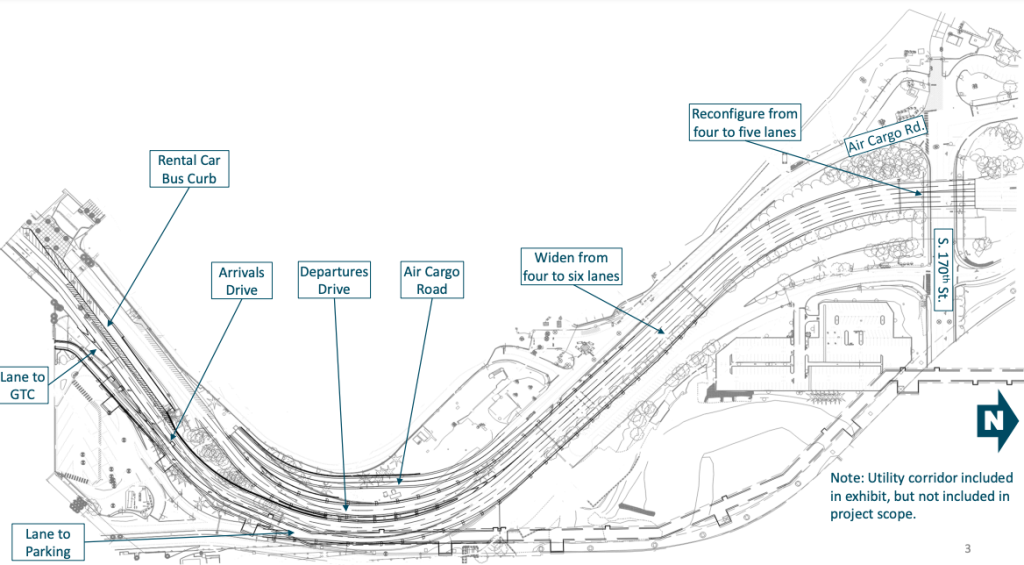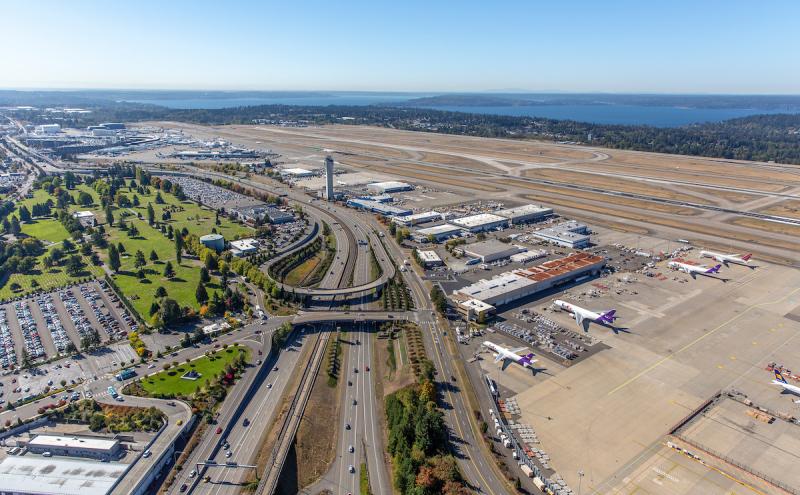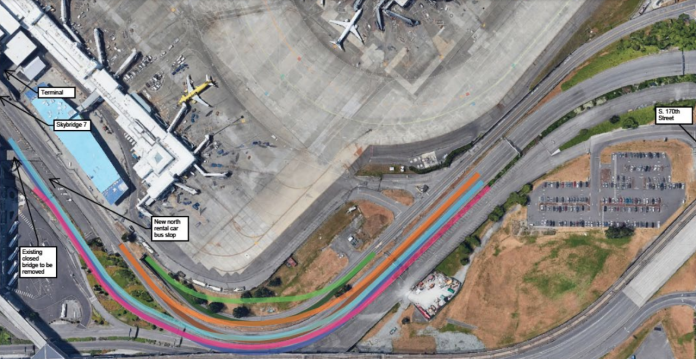The Port of Seattle’s plan to significantly expand the capacity of the main arrivals drive at Seattle-Tacoma International Airport (Sea-Tac) hit a speedbump in late September as most of the members of the Port of Seattle Commission voted to postpone a decision to move forward with design work for the project. Planned to open in 2025 if the current schedule is adhered to, the project would add two lanes to the main segment of Arrivals Drive, bringing the total number of lanes to six, and realign the other roads like Departures Drive to accommodate the widening.
A majority of the Commission expressed frustration with the fact that the Port doesn’t seem to have a very well-developed plan to reduce the percentage of trips to the airport that are made by single-occupancy vehicles and rideshares even as it moves forward with a plan to expand capacity of one of the airport’s key roadways.
Four of the five members of the Port of Seattle Commission voted to delay a formal vote on whether to approve spending an additional $6.9 million to continue design work to their November 9 meeting. That allocation would come after an authorization of $8 million in 2019 to get the project to 30%. The only member to vote against the delay was Commissioner Sam Cho, who also works at Lyft and who had recused himself from a discussion on surface transportation earlier this year because of that fact. Back in 2019, before Cho had joined the Commission, the other four Commissioners had been unanimous in approving the project to move forward with initial design work. But that was also before the project’s estimated cost went up from $50 million to nearly $80 million.
Perversely, the Port of Seattle is touting the expansion of one of the main roadways at Sea-Tac as supporting the mission of the Port to be the “greenest and most energy efficient Port in North America.”

Not only did a memo produced for the Commission note that “a byproduct of reduced congestion is a decrease in emissions from vehicles in traffic” but even more remarkably, the State Environmental Protection Act (SEPA) checklist completed by the Port earlier this year contends that the project will cause no net increase in emissions from vehicles using the new arrivals drive, because the project won’t generate any additional vehicular trips even as the road had been operating “at or above capacity” prior to the pandemic. Even when the project is complete, there are no plans to dedicate any of the new lanes to high occupancy vehicles or transit uses.
At the meeting, Commissioner Ryan Calkins highlighted the disconnect between the mode share goals that the Port sets for itself and the lack of an access fee to access the airport when arriving by a single-occupancy vehicle. The Widen Arrivals Drive project is being designed to accommodate a future project to implement access fees at the airport, but the Port has been very slow to develop that program even as it moves forward with this project expanding the roadway. Implementing an access fee was something that Commissioner Calkins discussed during his first campaign for Port Commission. Staff pushed back on a suggestion by Calkins that an access fee could be implemented by the time that this project opens in 2025, noting that the earliest it could be implemented would be 2027. The Arrivals Drive project is advancing separately from the Sustainable Airport Master Plan (SAMP), a suite of projects intended to advance the Port’s sustainability goals.

But it was Commissioner Stephanie Bowman who seemed most reluctant to approve the project. “To move forward with widening [Arrivals Drive] without at the same time integrating either transit or some other mode share as part of the planning process, I just can’t support that. I just can’t see how these two things would be separated.” Bowman asked why a dedicated lane for buses or shuttles was not being considered as part of the project, with Port staff insisting that dedicated space for transit would make traffic worse for everyone.
“We’ve been talking about this for years. I’ve been on the Commission six-and-a-half years and I still have not seen a real plan on ground transportation to get people out of single-occupancy vehicles,” Bowman said, after calling out the $80 million price tag on the project.
Commissioner Peter Steinbrueck also pressed staff for see additional analysis showing how the Port can produce increased mode shift, saying he saw only a “typical highway, ‘build it and they will come’ approach.” And Commission President Fred Felleman wanted to see more details on the traffic modeling that the Port used to rule out dedicated space on Arrivals drive for transit or shuttle buses.
Commissioner Calkins tried to paint the project as not a “typical highway or freeway,” noting that demand for Arrivals Drive is driven by the number of tickets sold on planes. But the unique nature of Sea-Tac airport actually heightens the need to take deliberative care with the analysis — the airport is a regional generator of trips in a way that few facilities are, and the decisions made about how people can access it have far-reaching ramifications. The complete lack of analysis shown in the SEPA checklist about how this could impact the Port’s mode share goals shows that the Port is not taking its role here seriously.
Sandra Kilroy, the Senior Director of Engineering, Environment, and Sustainability at the Port, said the Port is committed to addressing emissions from ground transportation and will be pursing strategies to do so “concurrently” to this project, but didn’t list any specific strategies, and fell into talking about a shift to electric vehicles rather than anything the Port has direct control over.
Sea-Tac’s current share of passengers arriving at the airport by transit is around 6%, in contrast with San Francisco at 14%. Port Commission members have been vocal in meetings about wanting luggage racks on Sound Transit trains and improving the rider experience coming to and from SeaTac’s light rail station along the long outdoor walkway on the side of the parking garage.
This project comes as the Washington State Department of Transportation inches forward with planning toward a second regional airport to handle increased demand for air travel in Western Washington. Sea-Tac airport is seeing some of the most rapid increases in greenhouse gas emissions regionally, with a nearly 60% increase in CO2 from air travel seen since 2008, and that doesn’t account for the use of ground transportation to access the airport. In November, we’ll see if the Port provides a better impact mitigation plan that will allow enough Commissioners to feel comfortable moving forward with the major roadway expansion project.
Ryan Packer has been writing for The Urbanist since 2015, and currently reports full-time as Contributing Editor. Their beats are transportation, land use, public space, traffic safety, and obscure community meetings. Packer has also reported for other regional outlets including BikePortland, Seattle Met, and PubliCola. They live in the Capitol Hill neighborhood of Seattle.


